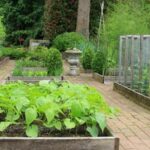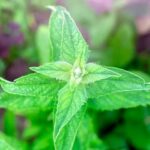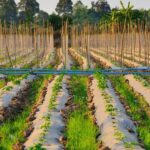In recent years, the trend of indoor vegetable gardens has been steadily growing in popularity as more people seek to incorporate fresh produce into their daily lives. With the convenience, health benefits, and sustainability that indoor gardening provides, it’s no wonder that many are turning to this method of growing their own food.
Growing vegetables indoors not only allows for easy access to nutritious ingredients for cooking but also serves as a creative and fulfilling hobby for those looking to add a touch of greenery to their living spaces. This article will delve into the world of indoor vegetable gardening, providing valuable insights on how to get started, choose the right plants, design your garden space, and effectively maintain your crops.
Whether you’re a beginner looking to dip your toes into indoor gardening or an experienced grower wanting to expand your knowledge, this comprehensive guide will cover everything from essential tools and materials needed for setting up an indoor garden to troubleshooting common issues like pests and diseases. Join us on this journey as we explore the immense possibilities of cultivating your very own homegrown vegetables indoors.
Benefits of Growing Vegetables Indoors
Growing vegetables indoors not only adds a touch of green to your living space but also brings an array of benefits for your health, convenience, and sustainability efforts. One key advantage of indoor vegetable gardens is the ability to have fresh produce at your fingertips year-round. This ensures that you have access to nutrient-rich vegetables without having to depend on store-bought options that may have traveled long distances and lost some of their nutritional value.
Health Benefits
Having an indoor vegetable garden allows you to control what goes into your plants, ensuring that no harmful chemicals or pesticides are used in the growing process. This leads to cleaner and safer produce for you and your family to enjoy. Additionally, having a constant supply of fresh vegetables encourages healthier eating habits, ultimately contributing to improved overall health and well-being.
Convenience and Sustainability
Another benefit of growing vegetables indoors is the convenience it offers. With an indoor garden, you can easily access the ingredients you need for cooking without having to make multiple trips to the grocery store. This not only saves time but also reduces your carbon footprint by decreasing the need for transportation of goods. Furthermore, indoor vegetable gardens promote sustainability by utilizing space efficiently and reducing food waste since you can harvest just the amount needed for each meal.
Getting Started
When embarking on the journey of creating an indoor vegetable garden, it is essential to ensure that you have the right tools and materials to set yourself up for success. One of the first things you will need is a suitable container for planting your vegetables. Depending on the size of your space and the types of plants you want to grow, options range from traditional pots and planters to innovative vertical gardens and hydroponic systems.
Soil and Fertilizer
Selecting the right soil is crucial for the health and growth of your indoor vegetable garden. Look for a high-quality potting mix that provides adequate drainage while retaining moisture. Additionally, consider incorporating organic fertilizers into your routine to ensure that your plants receive essential nutrients for robust growth. Remember to regularly check the pH levels of your soil to maintain optimal conditions for your vegetables.
Watering Tools and Lighting
Proper watering is key to the success of any garden, especially when growing vegetables indoors. Invest in watering cans or a drip irrigation system to provide consistent moisture without overwatering. In addition, consider installing grow lights or positioning your garden near a sunny window to ensure that your plants receive sufficient light for photosynthesis. Adequate lighting is essential for healthy growth and strong yields in an indoor environment.
By gathering these essential tools and materials, you can lay a solid foundation for setting up your own thriving indoor vegetable garden. The proper items will help create an optimal environment for your plants to flourish, providing you with fresh produce year-round while adding natural beauty to your living space.
With guidance on choosing containers, soil, watering tools, and lighting options, you are well on your way to enjoying the benefits of growing vegetables indoors armed with these must-have essentials.
Choosing the Right Plants
Indoor vegetable gardens offer a convenient and rewarding way to grow fresh produce right in the comfort of your home. When choosing the right plants for your indoor garden, there are several factors to consider. Herbs like basil, parsley, and chives thrive indoors due to their small size and adaptability to growing in pots. Leafy greens such as lettuce, spinach, and kale are also great options for indoor gardening as they do not require intense sunlight.
For those looking to grow more substantial vegetables indoors, consider compact varieties of tomatoes, peppers, and even dwarf varieties of cucumbers. These plants can be grown in larger containers or even hydroponic systems. It’s essential to provide adequate light for your indoor vegetables, either through natural sunlight from a south-facing window or with the use of grow lights. Regular watering is crucial, but be cautious not to overwater as this can lead to root rot.
In addition to choosing the right plants for your indoor vegetable garden, proper care is essential for their success. Monitor the temperature and humidity levels in your home to ensure optimal growing conditions. Regularly inspect your plants for any signs of pests or diseases, and address these issues promptly to prevent them from spreading. By selecting suitable vegetables and providing them with proper care, you can enjoy a bountiful harvest of fresh produce throughout the year right at your fingertips.
| Indoor Vegetable | Care Tips |
|---|---|
| Herbs (basil, parsley, chives) | Adaptability to grow in pots |
| Leafy Greens (lettuce, spinach, kale) | Do not require intense sunlight |
| Tomatoes, Peppers, Cucumbers | Adequate light and regular watering needed |
Designing Your Indoor Garden Space
When it comes to designing your indoor garden space, the key is to maximize the small area you have available in a creative and efficient way. One popular trend for indoor vegetable gardens is vertical gardening, where plants are grown upwards using wall-mounted planters or hanging containers. This not only saves floor space but also adds a visually appealing element to your indoor garden.
Another creative idea for maximizing small spaces is utilizing multi-tiered shelving units or plant stands. These can help create different levels for your plants to receive adequate sunlight and air circulation. Additionally, using a variety of container sizes and shapes can add dimension and interest to your indoor garden while making the most of the limited space you have.
For those with limited square footage, consider incorporating herbs or smaller vegetables that can thrive in smaller containers such as windowsill herb gardens or tabletop vegetable planters. This allows you to enjoy the benefits of homegrown produce without the need for a spacious garden area. By mixing and matching different types of plants and containers, you can create a unique and personalized indoor vegetable garden that fits perfectly into your living space.
No matter how small your indoor garden space may be, there are endless possibilities for creating a lush and thriving vegetable garden right in your own home. With some creativity, strategic planning, and the right tools, you can transform any corner of your living space into a green oasis filled with fresh produce that you can enjoy all year round.
Explore different design ideas and experiment with various plant combinations to find the perfect setup that suits both your style preferences and gardening needs.
Maintenance Tips
Maintaining a successful indoor vegetable garden requires careful attention to watering, lighting, and temperature control. Here are some essential maintenance tips to ensure that your plants thrive in their indoor environment:
- Watering: One of the most critical aspects of indoor gardening is proper watering. It’s essential to check the moisture level of the soil regularly and adjust your watering schedule accordingly. Overwatering can lead to root rot, while underwatering can cause nutrient deficiencies and stunted growth. Consider using a moisture meter to accurately monitor the soil’s moisture content.
- Lighting: Adequate light is crucial for healthy plant growth. Most vegetables require at least 6-8 hours of sunlight per day. If natural light is limited in your indoor space, you may need to supplement with artificial grow lights. LED grow lights are energy-efficient and provide the full spectrum of light needed for plant photosynthesis. Position your lights close enough to the plants without causing heat stress.
- Temperature Control: Maintaining the right temperature is key to the success of your indoor vegetable garden. Most vegetables thrive in temperatures between 65-75°F (18-24°C) during the day and slightly cooler at night. Be mindful of drafts from windows or vents, as sudden temperature fluctuations can stress plants. Using a thermometer in your growing area can help you monitor temperature levels effectively.
By following these maintenance tips for watering, lighting, and temperature control, you’ll create an ideal environment for your indoor vegetable garden to flourish. Remember that each plant may have specific needs, so it’s essential to observe and adapt to ensure optimal growth and productivity.
Incorporating these practices into your routine will not only result in a bountiful harvest but also provide you with fresh, organic produce year-round right from your own home. Check out some inspiring pictures of indoor vegetable gardens online for ideas on how you can design and maintain your own flourishing indoor garden space.
Troubleshooting Common Issues
When it comes to maintaining a successful indoor vegetable garden, there are some common issues that may arise along the way. Understanding how to troubleshoot problems such as pest control, diseases, and nutrient deficiencies is essential for ensuring the health and productivity of your plants. Here are some tips and techniques to help you tackle these challenges effectively:
- Pest Control: One of the most common issues in indoor gardening is dealing with pests that can harm your plants. To prevent infestations, regularly inspect your plants for any signs of bugs or insects. If you notice any unwanted visitors, consider using natural remedies such as neem oil or insecticidal soap to eliminate them without harming your plants.
- Diseases: Indoor plants are not immune to diseases, so it’s important to be vigilant about preventing and addressing any potential issues. Make sure to maintain good air circulation around your plants and avoid overwatering, as excess moisture can lead to fungal infections. If you notice any signs of disease such as wilting leaves or abnormal growth, act quickly to isolate affected plants and treat them with appropriate fungicides.
- Nutrient Deficiencies: Providing proper nutrition is crucial for healthy plant growth, but indoor environments can sometimes lead to nutrient deficiencies. Regularly check the leaves of your plants for any discoloration or unusual patterns, which could indicate a lack of essential nutrients. Consider using organic fertilizers or supplements to replenish nutrients and promote optimal plant health.
By being proactive in addressing these common issues, you can help ensure that your indoor vegetable garden thrives and continues to provide you with a bountiful harvest of homegrown produce. With the right knowledge and strategies in place, you’ll be able to enjoy the benefits of growing your own vegetables indoors all year round.
Harvesting and Enjoying Your Indoor Vegetable Garden
In conclusion, cultivating an indoor vegetable garden can be a rewarding and fulfilling experience that not only provides fresh produce but also promotes a healthier lifestyle. By incorporating the tips and suggestions provided in this guide, individuals can successfully start their own indoor garden with ease. From selecting the right vegetables to designing the perfect space, maintaining the garden, and troubleshooting issues, every step is crucial in ensuring a bountiful harvest.
One of the most satisfying aspects of indoor gardening is being able to harvest and enjoy the fruits of your labor. Whether it’s snipping fresh herbs for a meal, picking ripe tomatoes for a salad, or harvesting leafy greens for juicing, there’s something truly special about using homegrown produce in your daily cooking. The taste and quality of freshly picked vegetables are unparalleled, making each meal a delightful experience.
As you embark on this journey of indoor vegetable gardening, remember that patience and dedication are key. With proper care and attention to detail in watering, lighting, and controlling temperature, your plants will flourish and reward you with abundant harvests. And as you enjoy the process of growing your own food indoors, don’t forget to capture those memorable moments with pictures of your thriving indoor vegetable garden – a visual reminder of your green thumb success.
Frequently Asked Questions
What Are the Best Vegetable Plants to Grow Indoors?
Growing vegetables indoors can be a rewarding experience, and some of the best plants to grow include herbs like basil, cilantro, and chives. These plants are relatively low maintenance and can thrive in indoor environments with proper care.
What Vegetables Can Be Grown Indoors All Year Round?
When it comes to growing vegetables indoors all year round, options like lettuce, spinach, and microgreens are excellent choices. These vegetables have shorter growing cycles and can be harvested multiple times throughout the year, making them ideal for indoor gardening.
What Vegetables Are Good for Indoors?
Vegetables that are well-suited for indoor growing include cherry tomatoes, peppers, and green beans. These plants can thrive in containers or small spaces with adequate sunlight and temperature control. Additionally, leafy greens like kale and Swiss chard also do well indoors due to their compact growth habits.

If you’re looking to get into vegetable gardening, or are just looking for some tips on how to make your current garden better, then you’ve come to the right place! My name is Ethel and I have been gardening for years. In this blog, I’m going to share with you some of my best tips on how to create a successful vegetable garden.





